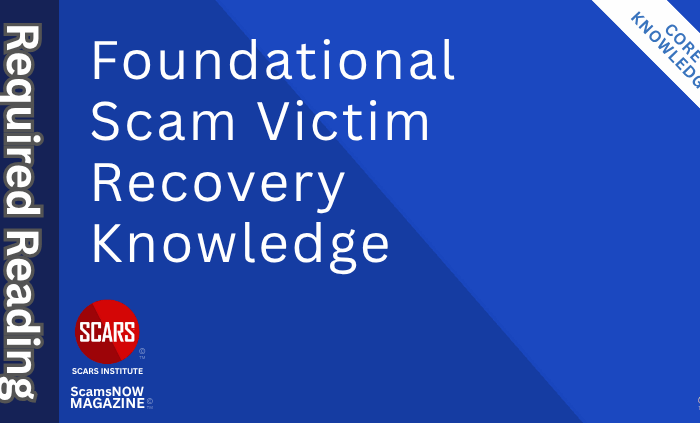
The Psychological Concept of Multiplicity and How Trauma Affects It
Multiplicity and Why it Matters to Traumatized Scam Victims
Primary Category: Scam Victim Recovery Psychology
Authors:
• Vianey Gonzalez B.Sc(Psych) – Licensed Psychologist, Specialty in Crime Victim Trauma Therapy, Neuropsychologist, Certified Deception Professional, Psychology Advisory Panel & Director of the Society of Citizens Against Relationship Scams Inc.
• Tim McGuinness, Ph.D., DFin, MCPO, MAnth – Anthropologist, Scientist, Polymath, Director of the Society of Citizens Against Relationship Scams Inc.
About This Article
Multiplicity explains how one mind can hold distinct parts with different roles, especially after scam trauma, and treats these inner states as understandable adaptations rather than defects. Everyday parts are common, while clinically significant patterns may include time loss, sharp state shifts, or changes in skills that warrant assessment by a clinician trained in dissociation. The approach reduces shame, makes symptoms workable, and provides a practical map for care. Core goals include safety and stabilization, co-consciousness, unblending from overwhelmed states, steady adult leadership, phased memory work, and integration of memory and function. Helpful methods include parts mapping, grounding, brief internal dialogues, compassion practices, and external supports such as routine and clear boundaries. Self-care covers daily logs, a parts first aid kit, grounding steps, and a shared safety plan when risk is present. Family and advocates support progress by keeping plans simple, using factual language, and protecting routines. With structure, respectful inner dialogue, and skilled guidance, the system can move from conflict to cooperation and daily life can steady.
Note: This article is intended for informational purposes and does not replace professional medical advice. If you are experiencing distress, please consult a qualified mental health professional.

Multiplicity and Why it Matters to Traumatized Scam Victims
Multiplicity in Trauma Therapy: A Plain-Language Guide
Author’s Note
This article addresses a technical topic that describes both a psychological pattern and the therapies that help restore steadier daily life. It asks the reader to slow down, think, and practice. That effort pays off. With a clearer picture of how parts operate and how treatment proceeds, a scam victim or survivor can get more value from therapy and understand why certain steps come first.
The material is educational. It does not diagnose or replace care. It is meant to sit beside work with a licensed clinician who has training in dissociation and trauma. Readers who feel overwhelmed should pause, use grounding skills, and return when settled. If safety is at risk, they should contact local emergency services or a trusted crisis line such as call 988 in the U.S. or Canada, or 800.911.2000 in Mexico.
The goal is practical insight. By learning how inner parts relate, how cooperation grows, and how daily structure supports progress, the reader can approach therapy with better questions and steadier expectations. That understanding reduces confusion, supports informed consent, and helps the reader take small actions that move life forward.
Lic. Vianey Gonzales & Tim McGuinness, Ph.D.
Introduction
Multiplicity describes how one mind can hold several “parts” or “self-states,” each with its own feelings, needs, memories, and roles. Instead of treating the mind as a single uniform voice, this view treats it as a small team that learned to share tasks under stress. The frame is neutral. Everyone has parts to some degree. In some people, especially after trauma, the parts become more separate and can feel very different from one another.
For scam victims, this picture often fits what they already notice inside. After a romance fraud, investment swindle, or identity theft, many people report sharp inner shifts. One part still believes the offender will make it right. Another part is furious and wants to shut everything down. A third part tries to keep daily life going and avoids thinking about the loss. These shifts can look messy from the outside, yet they make sense as attempts to stay safe, reduce pain, and keep functioning.
Multiplicity is not an exotic diagnosis and not a sign of weakness. It is better understood as the mind’s way to divide complex jobs. Before the scam, parts may have worked together smoothly. During the scam, the system faced intense pressure: secrecy, urgency, and manipulation. After the scam, the system faced shock, shame, and practical fallout. Under that strain, parts that once cooperated can pull apart. The result may include sudden changes in mood, bursts of anger or numbness, memory gaps for stressful moments, or strong internal conflict about what to do next.
This pattern is different from psychosis. Parts are inner states, not outside voices with independent bodies. Most people with multiplicity know these states live inside their own mind. They may feel distinct in age, posture, or viewpoint, but they are parts of one person. When stress is high, a part may take the wheel and push other parts to the background. When stress drops and safety rises, cooperation returns and awareness widens.
Therapy helps because it gives structure to this inner team. A therapist teaches skills that calm the body, organize daily routines, and bring parts into better communication. Sessions focus on safety, not on forcing memories or assigning blame. The work includes simple language such as “a part of me is hopeful” and “a part of me is scared,” which reduces internal fights. Over time, people learn to let a steady, adult stance lead. That stance listens to each part, thanks protective efforts, and sets clear limits that protect money, time, and health.
This approach also reduces shame. When someone sees anger, withdrawal, or people-pleasing as a role a part learned to survive, self-attack eases. Practical steps become easier. Examples include writing a one-paragraph summary of events, changing passwords with a manager, setting short call times with banks, and asking a trusted person to sit in on important calls. As parts work together, sleep improves, concentration returns, and decisions feel clearer.
An introduction to multiplicity gives scam victims a new way to understand their reactions. It explains why they can feel torn in opposite directions and why certain moments go fuzzy. It also points to hope. With guidance, the inner team can learn better cooperation. The goal is not to erase parts but to bring them into a working partnership that supports recovery. When that happens, the person still remembers the harm, but the harm no longer runs the system.
What Multiplicity Is Not
- It is not psychosis. Parts are inner states, not external entities. The person remains inside their own mind.
- It is not attention seeking. In trauma-linked patterns, parts usually developed as adaptations that helped the person survive.
- It is not created by ethical therapy. Responsible clinicians use neutral language, avoid heavy suggestion, and follow the person’s experience rather than imposing a story.
Multiplicity is Not “Split Personalities” or Schizophrenia
Multiplicity describes inner parts or self-states within one mind. It is a neutral way to talk about roles, feelings, and memories that may become more distinct after trauma. It is not the same as the outdated idea of “split personalities,” and it is not schizophrenia.
- “Split personalities” is a sensational label sometimes applied to Dissociative Identity Disorder (DID). While clinically significant multiplicity can include DID or OSDD, many people experience parts without meeting any disorder criteria.
- Schizophrenia is a psychotic disorder that can involve persistent hallucinations, fixed delusions, and disorganized thinking. Its causes, risks, and treatments are different from dissociation and parts work.
- Parts are experienced as inner states within one person. People using a parts model typically know these experiences are inside their own mind. That is different from perceiving voices or figures as coming from outside the self.
- If you struggle with external-sounding voices, paranoia, severe confusion about reality, or safety concerns, seek a licensed clinician promptly. Getting the right evaluation helps you receive the right kind of care.
What Multiplicity Covers
Multiplicity describes the mind as a system of “parts” or “self-states,” each with its own feelings, needs, memories, and roles. Rather than one uniform voice, a person can experience several inner players that learned different jobs over time. This frame is neutral. Everyone has parts to some degree. After trauma, those parts may feel more separated and more distinct from one another.
This guide explains how clinicians use a parts perspective, what signs point to clinically significant multiplicity, and how therapy helps. It stays in simple language and focuses on practical steps.
- Everyday parts many people recognize: a careful planner at work, a playful parent at home, a protective inner critic that tries to prevent mistakes.
- Clinically significant forms: stronger separations between parts that can include memory gaps, time loss, or shifts in handwriting, posture, and age sense. These patterns appear in dissociative conditions such as OSDD and DID.
- Related therapy models: Internal Family Systems (with Self, managers, firefighters, and exiles), Ego State Therapy, Structural Dissociation theory (apparently normal parts and emotional parts), Schema Therapy modes, and the Dialogical Self. Names differ, yet the shared idea is stable: inner states can relate to one another and can learn to work together.
In everyday life, most people shift among familiar parts without trouble. A careful planner shows up at work and tracks details. A playful parent appears at home and brings warmth to routine tasks. A protective inner critic tries to prevent mistakes and embarrassment, sometimes too forcefully. Other common parts include a social self that handles introductions, a private self that prefers quiet, and a problem solver that takes charge in emergencies. These shifts are normal role changes that reflect context, values, and learned habits. They usually feel continuous and under control.
Clinically significant forms look different. The separations between parts can become stronger and more disruptive. A person may lose time, discover missing conversations, or find items they do not recall buying. Handwriting, voice, posture, or age sense may change with the active state. Concentration can drop, and familiar places can feel strange. These patterns appear in dissociative conditions such as OSDD and DID. The experiences are internal and not the same as psychosis. Even so, they call for assessment by a clinician trained in dissociation. The first goals are safety, daily structure, and a clear plan for care.
Several therapy models organize this work. Internal Family Systems describes a steady leadership stance called Self and three broad roles for parts called managers, firefighters, and exiles. Ego State Therapy works with named states that hold specific memories and jobs, and builds cooperation among them. Structural Dissociation theory distinguishes between apparently normal parts that run daily life and emotional parts that hold trauma responses, and it uses phased treatment. Schema Therapy describes modes such as Vulnerable Child, Angry Child, Healthy Adult, and Punitive Parent to guide skills and limits. The Dialogical Self highlights inner voices and their conversations. Names and maps differ, but the shared idea is stable. Inner states can relate to one another, can learn new roles, and can work together. When this cooperation grows, daily life becomes steadier and the person has more choice about which part leads in each moment.
Is Multiplicity Related to Dissociative Identity Disorder (DID)?
Multiplicity and Dissociative Identity Disorder (DID) are related, but they are not the same.
Multiplicity is a broad, neutral idea. It describes a mind with “parts” or self-states that hold different feelings, needs, memories, and roles. Everyone has parts to some degree. After trauma, parts can feel more distinct and may pull in different directions. This can be workable in therapy without any diagnosis.
DID is a specific psychiatric diagnosis. It involves persistent identity disruption with marked separation among parts, regular amnesia or time loss, and clinically significant distress or impairment. Some people with multiplicity meet criteria for DID. Most do not. Others may meet criteria for OSDD, which lies in the same diagnostic family but looks somewhat different.
Think of multiplicity as the umbrella and DID as one pattern under that umbrella. The overlap appears when separation is strong and memory problems interfere with daily life. The difference shows up in severity, frequency, and impact.
A parts-informed approach helps across this range. Early work emphasizes safety, steady routines, continuing education and awareness, grounding, and respectful communication among parts. As stability grows, therapy builds co-consciousness so more of the person knows what is happening more of the time. Only later does careful trauma processing begin, and only if stability holds.
An assessment by a clinician trained in dissociation is wise if any of the following are present:
- Repeated time loss,
- Finding items or messages you do not recall,
- Strong shifts in voice or posture that feel “not me,”
- Inner voices with distinct names and roles, or
- Episodes that disrupt work, school, or relationships.
The goal of care is not to erase parts. The goal is reliable daily life, safer choices, and coordinated action inside one person.
Why Therapists Use a Parts Frame
- It reduces shame. Inner conflict becomes something understandable: a relationship among parts that learned different survival jobs.
- It makes symptoms workable. Panic, numbness, or anger can be explored as protective roles rather than personal defects.
- It offers a practical map for trauma work. When experiences feel disconnected or contradictory, a parts map brings order and suggests next steps.
Therapists use a parts frame because it turns confusion into something workable. Inner conflict is reframed as a relationship among parts that learned different survival jobs, which lowers shame and opens the door to change. Symptoms become easier to handle. Panic can be seen as a protector that sounds the alarm too often. Numbness can be seen as a shield that stays on after danger has passed. Anger can be seen as a bodyguard that needs clearer rules. With this view, the person and clinician can set simple goals, test small steps, and track results. The frame also supplies a practical map for trauma work. When experiences feel disconnected or contradictory, a parts map shows who needs attention, what skills to build, and when to pause. It supports consent, pacing, and teamwork across methods such as Internal Family Systems, Ego State Therapy, Schema modes, and Structural Dissociation, while keeping daily safety and function at the center.
Common Signs That Call for a Professional Assessment
- Strong, rapid shifts in mood, voice, age sense, or posture that feel “not me.”
- Internal voices or named parts with distinct preferences or opinions.
- Time loss: missing conversations, gaps in the day, or finding items that the person does not recall buying.
- Skill or handwriting changes that track with state shifts.
These signs do not prove a diagnosis. They signal the need for assessment by a clinician trained in dissociation.
These signs describe patterns that may point to clinically significant multiplicity, yet they do not confirm a diagnosis. A person may show strong, rapid shifts in mood, voice, age sense, or posture that feel “not me.” The voice may turn softer or harder, the body may hold itself differently, or the person may suddenly feel much younger or older, often after stress or reminders of past events. Inner experience may include organized voices or named parts with distinct preferences and opinions that repeat across situations. These are sensed as inside the mind, not as outside voices. Daily life may show time loss, such as missing pieces of a day, gaps in conversations, unexplained calls or messages, or items bought without recall. Calendars, bank activity, or location histories may reveal actions the person cannot remember. Skills can also shift with the active state. Handwriting may change style within hours. A routine task can feel foreign, or typing speed and word choice can vary in ways others notice. Some people even switch handedness under pressure. These patterns tend to cluster around stress, conflict, or reminders and can disrupt work, school, and relationships. None of these signs proves a disorder. They signal the need for a careful assessment by a licensed clinician who has training in dissociation. A practical next step is to keep a brief log that notes dates, times, triggers, and what others observed, then bring that record to the appointment so the evaluation starts with clear, concrete information.
When to Address Multiplicity After Trauma
A parts-informed approach can begin early, but depth and pace depend on safety and stability. Clinicians stage the work so the person is not overwhelmed.
Stage 1: Crisis and stabilization (days to first few weeks)
-
- Priority is safety, medical needs, sleep, nutrition, and substance use control.
- Multiplicity is acknowledged with simple education, not deep exploration.
- Skills focus on grounding, orientation to time and place, and daily routine.
Stage 2: Early assessment and gentle parts work (weeks 2–12)
-
- Once the person can reduce arousal with basic skills and keep a simple routine, the therapist introduces light parts language.
- Goals include unblending (“a part of me feels X”), short check-ins, and a brief parts map tied to present-day safety.
Stage 3: Building cooperation and co-consciousness (months 2–6)
-
- With steadier sleep and structure, the focus shifts to communication among parts, role updates, and reducing time loss.
- The person practices planned handoffs between states and uses a weekly log to track triggers and responses.
Stage 4: Phased trauma processing (after reliable stability)
-
- Memory work begins only when the person shows consistent regulation, minimal self-harm risk, and dependable support.
- Sessions stay brief and titrated, with clear stop rules and post-session grounding.
Stage 5: Consolidation and integration (ongoing)
-
-
The system strengthens teamwork, restores daily roles, and revisits remaining hot spots in small pieces.
-
Start sooner if red flags appear
-
-
Frequent time loss, dangerous dissociation while driving or caring for children, command-type inner voices related to self-harm, or amnesia around medications call for immediate, structured parts-informed care alongside safety planning.
-
Readiness checklist for moving beyond basics
-
- Suicidality and violence risk managed with a written plan.
- Sleep averages 6–8 hours with predictable wake and wind-down times.
- The person can bring arousal down within 10–15 minutes using skills.
- Substance use is stable or in active treatment.
- A supporter knows the safety plan and how to help.
In practice, addressing multiplicity should start in week one with language and stabilization, grows into gentle mapping in weeks two to twelve, and moves toward deeper work only when the person is reliably safe, regulated, and supported.
Typical Core Goals in Treatment
- Safety and stabilization first. Therapy reduces self-harm risk, substance use, and daily chaos. Sleep, meals, movement, and routine receive early attention.
- Better communication and cooperation among parts. The aim is co-consciousness, where more of the person knows what is happening more of the time.
- Unblending from overwhelmed states. Instead of “I am only rage,” the stance becomes “a part of me feels rage and another part wants to slow down.”
- Steady leadership from a calm, adult stance. IFS calls this Self. From that position, a person listens to parts, thanks protective efforts, sets limits, and chooses the next step.
- Phased processing of trauma memories once stability holds. Work proceeds in careful steps so the system remains inside a tolerable range.
- Integration of memory and function. For some, parts gradually merge. For others, durable teamwork forms without amnesia.
Typical Methods That Help
Parts mapping
The person and therapist list parts, their roles, their triggers, and what each part tries to protect.
Parts mapping gives the work a clear picture. The person and therapist list each part, the job it learned, the triggers that bring it forward, and what it tries to protect. They note strengths as well as problems, then sketch safer roles that fit today’s life. The map starts simple and grows over time. It can include brief examples, such as how the Planner handles bills, how the Protector avoids certain calls, and how the Scared Child reacts to raised voices. The map helps set priorities for sessions and shows which skills to practice first.
Grounding and state regulation
Breathing, orienting to time and place, using the five senses, and gentle movement lower arousal and clear fog.
Grounding and state regulation keep the system inside a tolerable range. The person practices slow breathing, names the date and location out loud, and uses the five senses to anchor in the present. Cool water on the hands, a short walk, or light stretching often lowers arousal and clears fog. A timer can cue these steps every few hours. The person tracks results on a simple 0 to 10 scale so progress is visible and small gains are reinforced.
Unblending skills
The person observes the active part, names its job, appreciates its intention to help, and chooses an action that fits current safety and values.
Unblending skills help the person stay in charge when a strong state takes over. The person notices which part is active, names its job, appreciates its intention to help, and then chooses an action that matches current safety and values. Simple language supports this shift, such as “a part of me is scared and another part can make the call.” A written plan outlines who drives during work, who rests during meals, and how to hand the wheel back to the steady adult stance after a trigger.
Internal dialogues or imagery
A structured inner meeting allows parts to speak in turn while a calm leader sets the agenda and closes the session.
Internal dialogues or imagery bring order to the inner team. The person sets a short meeting in a calm mental space, invites one part to speak at a time, and keeps to an agenda. The ‘leader’ stance summarizes what was heard, states limits, and closes the session on time. Notes capture any agreements, such as a Protector’s new role to check doors once, not ten times. This structure reduces internal arguing and turns competing impulses into tasks that can be scheduled.
Compassion practices
The tone shifts from self-attack to curiosity: “Why did this part take over, and how did it try to keep me safe?”
Compassion practices change the tone of the work. Instead of self-attack, the person asks, “Why did this part take over, and how did it try to keep me safe?” A hand on the heart, a warmer inner voice, and accurate responsibility statements support this shift. The person thanks a part for its past service, updates the job for current safety, and corrects mistakes without shame. This approach lowers defensiveness, reduces the need for harsh control, and makes cooperation more likely.
External supports
Predictable routines, secure relationships, and clear boundaries stabilize life while inner work proceeds.
External supports stabilize daily life so inner work can succeed. The person keeps predictable routines for sleep, meals, work blocks, and breaks. A small circle of trusted people knows the safety plan and the best ways to help. Boundaries are clear for contact, money, and digital use. Calendars, reminders, and checklists back up memory when stress is high. These external anchors reduce surprises, shorten recovery after triggers, and free attention for therapy tasks.
Benefits People Often See Over Time
- Fewer blackouts and less time loss.
- Smoother transitions between states and fewer extreme swings.
- Better decisions during high stress because a calm ‘leader’ part stays in charge.
- More consistent functioning at work or school and steadier relationships.
x Over time, many people report fewer blackouts and less time loss. As daily structure improves and parts learn to share information, gaps in memory begin to shrink. A simple log of triggers, state shifts, and handoffs helps the system notice patterns and prepare for known stress points. Grounding before and after difficult tasks also keeps awareness continuous. The result is a more reliable recall of conversations, errands, and commitments, which reduces embarrassment, late fees, and missed appointments. Life feels more connected and less confusing.
Transitions between states usually become smoother as cooperation grows. Instead of abrupt takeovers that surprise the person and those around them, parts begin to signal before stepping forward. A short internal check-in, a breath cycle, or a planned word cue can allow a calmer changeover. The active part completes a task, then hands back control. When a trigger appears, the system can downshift in stages rather than snap into a single extreme. This gentler movement cuts emotional whiplash and lowers conflict at home and at work.
Decision quality in high-stress moments improves when a steady leadership stance stays in charge. The person practices short pauses, clear priorities, and written plans for known hot spots such as money calls, medical visits, or confrontations. Protective parts are heard but do not run the whole interaction. The leader part thanks them, sets limits, and follows a brief script. With practice, choices align with current safety and values rather than with past danger. Fewer impulsive actions and fewer withdrawals follow.
Functioning grows more consistent at work or school, and relationships steady. Regular sleep, meals, and movement support attention and mood. Calendars, reminders, and checklists back up memory on busy days. Boundaries for time, money, and digital contact protect focus and reduce drama. Family and trusted friends learn what helps and what does not, which lowers misunderstandings. Supervisors and teachers often notice improved reliability and clearer communication. Crises still arise, yet they are shorter and easier to repair.
These gains do not arrive all at once. They tend to build in small steps as safety improves, parts cooperate, and routines take root. Setbacks become information rather than failure, and the system returns to its plan with minor adjustments. Over months, the person sees a workable path forward.
Practical Self-Care While Seeking Help
Track state shifts and triggers in a simple daily log.
Short notes beat long journals.
A simple daily log gives the work structure. The person tracks state shifts and triggers in short notes, since brief entries are easier to maintain than long journals. A basic template works well: time, trigger, active part or state, intensity on a 0 to 10 scale, action taken, and result. An entry might read, “3:15 p.m., bank email, Protector active, 7 of 10, named date and place, slow breath x10, cleared in 12 minutes.” The log can live in a pocket notebook or a notes app. A two-minute review in the morning sets expectations and a two-minute review in the evening captures patterns. Over a week the log reveals what brings on shifts and which responses help most.
Use grounding when confusion, fog, or age shifts appear.
Name the date and location out loud, then list what the five senses observe.
Grounding and state regulation reduce confusion, fog, and age shifts. The person names the date, time, and location out loud, then lists what the five senses observe. They look for five visible items, identify four sounds, touch three textures, notice two scents, and taste one item such as a mint. Cool water on the hands, feet flat on the floor, a short walk, or light stretching help the body settle. Breathing follows a simple count, such as four in and six out, for two minutes. A phone reminder every few hours prompts a quick reset during busy days. The aim is not perfection. The aim is a repeatable routine that brings arousal down within minutes.
Build a “parts first aid kit” on paper.
List what calms the anxious part, what steadies the angry part, and what awakens the numb part.
A “parts first aid kit” on paper turns insight into action. The person lists what calms the anxious part, what steadies the angry part, and what awakens the numb part. Examples include box breathing, a warm drink, and a weighted throw for anxiety; a paced walk, an unsent letter, push-ups, or a cool rinse for anger; upbeat music, a citrus scent, bright light, a brisk walk, or a cold splash for numbness. A Scared Child part may respond to a blanket, a calm voice, and a short list of safe contacts. The kit goes on a small card in a wallet and a larger page at home. The person updates it monthly and checks items against the log to confirm what still helps.
Share a brief safety plan with a trusted person if self-harm risk exists.
Include numbers to call, steps to try first, and signals that mean “I need support now.”
A brief safety plan protects life when risk rises. The person names early warning signs, lists steps to try first, and identifies contacts who can respond. The plan includes numbers to call, a code phrase that signals “I need support now,” and clear rules for when to call emergency services. It can also include practical safeguards such as secure storage for medicines or removing access to hazards during high-risk periods. One trusted person receives a copy. The pair walks through the plan once so both know what to do. A pinned phone note or a printed card keeps the plan easy to find.
Seek a clinician with dissociation training for assessment and planning.
Bring the one-paragraph summary of concerns and the daily log.
Finding a clinician with dissociation training organizes care. The person asks about training, experience with DID and OSDD, and typical methods such as Internal Family Systems, Ego State work, or phased treatment for structural dissociation. They prepare a one-paragraph summary with dates, key events, current symptoms, and specific risks, and they bring the daily log. A short list of medicines, past therapies, and three goals helps the first session stay focused. The person asks for a staged plan that starts with safety and structure, then moves to cooperation among parts, and only later to memory work if stability holds. If a waitlist exists, the person requests interim support such as skills groups, reading, or check-ins. While waiting, they keep the log, use grounding, update the kit, and review the safety plan with the trusted contact. Step by step, these actions make therapy more effective and daily life more steady.
A Closer Look at Everyday Parts Versus Clinical Separation
Every person shifts between roles during a normal week. A planner part runs a meeting. A playful part reads to a child. A private part prefers quiet on a crowded train. These are ordinary state changes that feel like one continuous self.
After trauma, separations can become sharper – here are some examples.
- A ‘protector’ part might push away friends.
- A ‘caretaker’ part might overwork to keep everyone calm.
- An ‘angry’ part might defend the system by picking fights,
- A ‘frightened’ part stays hidden.
If these shifts include gaps in memory, time loss, or a strong sense of “that was not me,” the pattern rises to clinical significance. Therapy looks for safer cooperation rather than trying to erase parts. The system learned these roles for reasons that made sense in past danger. The task now is to update those roles for current safety.
How Therapy Builds Cooperation
Therapy builds cooperation by treating the inner system like a team with a shared mission. Sessions open with a brief status review, set a clear agenda, and pick one small target for the hour. The clinician keeps work inside a tolerable range and closes with specific next steps. Each session includes a short grounding exercise at the start and the end so the person returns to daily life steady and oriented. When a protector, a critic, or a younger state wants to speak, the clinician invites it to share for a few minutes, then returns leadership to a calm adult stance that can weigh options and decide.
Homework stays short and repeatable. Five minutes of grounding morning and night, one page of parts mapping each week, and a two minute check-in after stressful events give the system reliable touch points. The person practices a simple handoff script such as “thank you for warning me, I will handle this call and ask for your help if needed.” A written plan names who drives at work, who rests during meals, and who helps with sleep. The person records results in a small log so progress is visible and setbacks become information rather than failure.
Tone matters. Parts that cause trouble often act from fear or habit. The clinician helps the person thank a part for trying to help, name the cost of its old job, and offer a safer role that fits current life. A guard that once pushed people away can check doors once, not ten times. A younger state that panics at raised voices can step back while the adult schedules the conversation. Limits are clear and kind. If intensity rises, the session pauses for grounding and returns only when the system is ready.
Over time this structure builds co-consciousness. More of the person knows what is happening more of the time. Decisions line up with safety and values. Transitions smooth out. The team learns to work together, and daily life steadies.
Safety and Daily Structure Come First
Parts work moves best on a steady base. Early sessions target sleep, meals, movement, and reliable anchors in time and place. The person sets consistent wake and wind-down times and protects them as standing appointments. A short wind-down ritual helps, such as dim lights, warm tea, a brief stretch, and a few lines of reading. Screens go off at least one hour before bed. Caffeine use moves earlier in the day, and hydration rises. Mornings begin with light at a window or a brief step outside to set the body clock.
Meals are simple and regular. The person plans three basics and two snacks, with some protein at each sitting. Batch cooking on one quiet day reduces effort when stress is high. Movement is gentle and repeatable. A daily walk, light stretching, or body-weight exercises keep tension lower and improve sleep. A timer creates short work blocks with breaks, such as twenty minutes on and five minutes off. Alarms, calendars, and sticky notes support memory for bills, calls, and medicines.
Digital life gets tidy. A password manager and two-factor authentication protect accounts. Notifications turn off for high-trigger channels. Set times for email and news prevent all-day arousal. The person chooses two check-in windows for messages and stays out the rest of the day. A short morning plan and a short evening review bookend the hours. These small habits keep arousal down so parts do not need to take over.
Safety measures sit close at hand. Medicines are organized. If risk is present, access to hazards is limited and a supporter knows the plan. A pocket card lists the date, time, location, and one grounding step. A small kit carries a soothing scent, a tactile item, and a brief script that says who leads and what comes next. The person practices naming the active state, thanking it, and returning the wheel to a steady adult stance. With sleep, food, movement, and clear cues in place, the inner system relaxes, communication improves, and therapy can proceed without constant crisis.
Working With Memories Without Overwhelm
Memory work begins only when stability holds. The therapist and the person agree on clear goals, safety rules, and support between sessions. A short readiness checklist guides the decision. Sleep and meals are steady. Basic grounding works within minutes. Self-harm risk is covered by a written plan. Substance use is stable or in treatment. With those elements in place, trauma processing proceeds in small, scheduled pieces.
The work uses a phased plan. The therapist helps the person select a single, narrow target such as one image, one sound, or one moment from a larger event. They prepare resources first. These include a calming image, a present-day orientation script that names the date and location, and two or three skills that reliably lower arousal. A stop plan is stated aloud. It includes a hand signal, a word that means pause now, and a brief reset routine. The aim is not to relive everything. The aim is to connect memory to the present safely, so the system stops treating today as the past.
During sessions, the therapist maintains dual awareness. One part of attention visits the memory while another part stays anchored in the room. The person names what the five senses notice in the office at intervals. The therapist checks arousal with a simple 0 to 10 scale and slows or pauses when intensity rises above a preset number. Short sets of recall alternate with grounding and present-day statements such as “I am here, I am safe enough, this is a memory.” Protective parts are invited to observe rather than take over. Younger parts are oriented to the current year and reassured that the adult stance is present and in charge.
Containment skills support control of pace. The person practices placing unfinished material in a mental container that closes on request. The therapist reinforces start and stop boundaries by opening the session with a short ritual and closing with the same steps each time. When strong body reactions appear, the pair uses simple regulation tools such as paced breath, muscle release, and a change of posture. The rule is small doses, frequent grounding, and a clear exit.
After sessions, the person follows a recovery plan. Hydration comes first, then a light snack with protein. A brief walk or light stretching resets the body. Screen time stays limited for the rest of the day. Work returns in small blocks with breaks. The person uses a short log to note any echoes such as dreams, images, or mood shifts, and to record what skills helped. A supporter may check in by text or call that evening using a simple script. If distress spikes, the stop plan moves into action, and the clinician is contacted according to the agreed protocol.
Progress is measured by practical changes. Triggers lose intensity. Time loss shrinks. Nightmares ease. The person can recall what happened without entering a crisis. If overwhelm returns, the plan steps back to stabilization and cooperation among parts, then returns to memory work when readiness again holds. The process stays paced, respectful, and anchored in daily safety.
When to Seek Specialized Care
A person benefits from a specialist when patterns move beyond ordinary stress and routine coping. Frequent time loss, strong inner conflicts that block work or relationships, self-harm risk, or intense reactions to reminders that do not settle with basic grounding point to the need for expert help. Dissociation while driving or while caring for children, episodes of confusion about place and time, or inner voices that issue commands also raise urgency. If symptoms flare after attempts at standard counseling or if medication changes do not reduce distress, a referral to a clinician with dissociation training is appropriate.
A specialist provides a careful assessment, a phased plan, and coordination with medical care when needed. The assessment reviews history, current symptoms, safety needs, and daily functioning. The plan usually begins with stabilization, builds communication among parts, and introduces memory work only after reliable regulation is in place. Coordination may include sleep care, treatment for pain, or support for substance use recovery so progress is not undermined by untreated conditions.
Preparation improves the first visit. The person brings a one paragraph summary of concerns, a list of medicines and doses, a brief daily log that shows triggers and state shifts, and a written safety plan if risk is present. They ask the clinician about training with DID and OSDD, common methods used, and how crises are handled between sessions. They confirm confidentiality limits and points of contact.
Early referral is wise when daily life is disrupted. Specialized care shortens the time to a workable plan and reduces the chance of repeated setbacks. With the right match, the person gains a clear roadmap, steadier routines, and support that fits the way dissociation works.
How Family, Friends, and Advocates Can Support the Process
Family, friends, and advocates help most when they stay steady and practical. They ask which routines make the day easier and then protect those routines. They keep plans simple, on time, and clearly written. They avoid arguing about which part is real and instead focus on what is safe and what comes next. They know the person’s safety plan, keep the numbers handy, and use brief, factual language during tough moments. Support does not mean solving everything. It means keeping life predictable while therapy proceeds.
Helpful communication is concrete and calm. Supporters use short sentences, name the current step, and confirm time and place. They offer two clear choices, such as “call now or call at two,” instead of open-ended demands. When a strong state is active, they speak to the adult stance with respect for the part that is present. They avoid debates about memories, do not press for details, and do not judge protective behaviors that formed in past danger. They ask what helps right now and follow the plan the person has prepared with the clinician.
Practical help lowers stress. Supporters can offer rides to appointments, prepare simple meals, and hold a short check-in at the same time each day. They can stand by during a call to the bank or a doctor and then step back when it is done. They can reduce noise and clutter at home, keep lighting steady in the evening, and limit surprise visits or sudden changes to plans. These small adjustments reduce triggers and the need for parts to take over.
Boundaries protect both sides. Supporters agree on times they can be reached, tasks they can do, and lines they cannot cross. They state these limits kindly and keep them. They respect privacy about therapy notes and logs unless safety rules require action. They do not take on the role of clinician. They encourage contact with a qualified professional and step in only as the safety plan directs. When they make a mistake, they repair it with a simple apology and a return to the plan.
Advocates in workplaces, schools, and victim community settings keep requests modest and specific. They ask for predictable schedules, a quiet space for short breaks, or written summaries after meetings. They document agreements and check them monthly. They avoid labels and focus on function, such as on-time starts, clear tasks, and brief pauses when stress rises.
Support also includes care for the supporter. Rest, food, and their own steady routines keep patience intact. With this foundation, the person feels backed by a reliable circle, therapy has room to work, and daily life moves forward with fewer shocks and fewer setbacks.
A Short Example of Parts Mapping
- List of parts: Planner, Protector, Caretaker, Angry Teen, Scared Child, Numb Watcher.
- Jobs they try to do: Planner organizes work. Protector keeps people at a distance. Caretaker prevents conflict. Angry Teen pushes back when others control. Scared Child hides when voices rise. Numb Watcher turns off feelings to avoid pain.
- Triggers: Sharp voices, deadlines, unexpected bills, crowded rooms.
- Safer roles today: Protector checks doors and keeps appointments on time. Caretaker schedules one friend call a week. Angry Teen advocates in meetings with a written list instead of an outburst. Scared Child rests on the couch with a blanket while the adult makes dinner. Numb Watcher runs a five-minute body scan, then hands the wheel back to the adult stance.
This simple map turns confusion into a plan. Each part receives respect and a job that matches current safety.
Frequently Asked Questions
- Will parts disappear? Some people experience blending or merging. Others keep a clear sense of parts but lose amnesia and conflict. The outcome varies. The shared goal is better cooperation and a reliable daily life.
- Is medication required? Medication can help with sleep, anxiety, depression, or attention when needed. Medication does not remove parts. It supports stability while therapy builds skills.
- How long does this take? Progress depends on safety, support, the level of separation, and the person’s commitment. People often notice early gains in grounding and unblending. Deeper cooperation and memory integration take longer.
Conclusion
Multiplicity views the mind as a system of parts that formed for understandable reasons, often in response to stress and danger. Therapy sets out to bring communication, safety, and coordinated action to that system so the whole person functions better. When routines are steady, inner dialogue is respectful, and guidance is skilled, the system can shift from conflict to cooperation, from time loss to awareness, and from survival reflexes to choices that match today’s life.
This frame reduces shame by treating symptoms as protective roles rather than as defects. Panic signals a part that tries to keep the body safe. Numbness shows a part that learned to shut feelings off. Anger reflects a part that stands guard. With that understanding, work becomes practical. Sessions begin with stabilization, build co-consciousness so more of the person knows what is happening more of the time, and proceed to careful memory processing only when daily life is stable. The outcome is integration of memory and function. For some, parts blend. For others, parts remain distinct but cooperate without amnesia.
Daily structure supports these gains. Sleep, meals, movement, and simple time anchors lower arousal so parts do not need to take over as often. A brief log of triggers and state shifts turns confusion into a map. Grounding and unblending skills help the person notice which part is active, thank its intention, and return leadership to a calm adult stance. Family and friends reinforce progress by keeping plans simple, speaking in clear, factual language, and following the agreed safety plan.
Specialized care is important when time loss, strong inner conflicts, or high risk appears. A clinician trained in dissociation provides assessment, a phased plan, and coordination with medical care when needed. The tone of therapy remains respectful throughout. Even parts that create trouble usually act from fear or habit. When their efforts are recognized and their jobs are updated for present safety, resistance softens and cooperation grows.
In the end, multiplicity offers a workable path. It explains why experiences may feel divided and shows how those divisions can become a team. Step by step, the system learns to share information, hand off tasks, and make choices that fit the current day. Life becomes more predictable, relationships steadier, and work or school more consistent. The person moves from surviving to living with purpose.
Reference
- International Society for the Study of Trauma and Dissociation (ISSTD) treatment guidelines for adults with DID. Practical, phased care and safety-first orientation. ISSTD
- American Psychological Association clinical guideline for adults with complex trauma histories. Broad, evidence-based care recommendations relevant to dissociation. American Psychological Association
- Van der Hart, Nijenhuis, & Steele, The Haunted Self. Foundational book on structural dissociation and phased treatment for complex trauma.
- Putnam, “Pierre Janet and modern views of dissociation.” Historical roots that link dissociation to trauma and treatment principles. SpringerLink
- Spitzer et al., “Recent developments in the theory of dissociation.” Clear review of dissociation concepts and mechanisms. PMC
- Wainipitapong et al., “Assessing dissociation: A systematic review.” Up-to-date look at dissociation measures and their quality. PMC
- Hodgdon et al., “Internal Family Systems (IFS) Therapy for PTSD.” Early outcome data for a parts-based model applied to trauma. Taylor & Francis Online
- Leutner et al., “The concept of ego state: From historical background to modern therapy.” Overview of ego state therapy and its use with trauma. ScienceDirect
- American Psychiatric Association, “What Are Dissociative Disorders?” Accessible definition, symptoms, and care pathways. American Psychiatric Association
- World Health Organization, ICD-11 clinical descriptions for dissociative disorders. Official diagnostic descriptions including DID. IRIS
Article Glossary
- Adult stance: A calm leadership position the person cultivates to make balanced choices while respecting input from parts.
- Angry Teen (example part): A defensive inner state that pushes back when others control or criticize; used in the article as a sample role.
- Apparently Normal Parts (ANPs): In Structural Dissociation, parts that run daily life and avoid trauma material.
- Caregiver/Caretaker (example part): An inner state that overworks to keep peace and prevent conflict; example role in the parts map.
- Co-consciousness: Shared awareness across parts so more of the person knows what is happening more of the time.
- Compassion practices: Skills that replace self-attack with curiosity about why a part acted and how it tried to protect.
- Containment: A mental method for placing unfinished material in an imagined container to control pace during and after sessions.
- Dialogical Self: A model that views inner life as conversations among internal voices or positions.
- Dissociation: A disruption in memory, identity, emotion, or perception that can produce time loss, detachment, or state shifts.
- Dissociative Identity Disorder (DID): A diagnosis marked by persistent identity disruption, amnesia, and impairment due to strong separation among parts.
- Ego State Therapy: An approach that works with named states holding specific memories and roles, building cooperation among them.
- Emotional Parts (EPs): In Structural Dissociation, parts that carry trauma responses such as fear, rage, or shame.
- External supports: Predictable routines, secure relationships, and clear boundaries that keep daily life steady while treatment proceeds.
- Grounding: Present-moment actions that lower arousal and clear fog, such as orienting to date and place and using the five senses.
- Internal dialogues or imagery: Structured inner meetings where parts speak in turn and a steady leader sets limits and next steps.
- Internal Family Systems (IFS): A model that includes Self as steady leadership and groups parts as managers, firefighters, and exiles.
- Integration: Improved linkage of memory and function so parts cooperate without amnesia; for some, parts blend.
- Memory work: Phased processing of trauma memories in small, titrated pieces once stability holds.
- Multiplicity: A neutral frame that understands one mind as a system of parts or self-states with different roles, feelings, and memories.
- Numb Watcher (example part): An inner state that turns feelings off to avoid pain; example role in the parts map.
- Other Specified Dissociative Disorder (OSDD): A dissociative condition related to DID with notable separation among parts that does not meet full DID criteria.
- Parts first aid kit: A written list of quick helps tailored to anxious, angry, and numb states for use during spikes in distress.
- Parts mapping: A working list of parts, their jobs, triggers, and safer updated roles that guides session goals.
- Phased treatment: A staged plan that starts with stabilization, builds cooperation, and processes memories only after reliable regulation.
- Planner (example part): An organized state that manages tasks and schedules; example role in the parts map.
- Protector (example part): A guard-like state that keeps people at a distance or pushes away risk; example role in the parts map.
- Readiness checklist: Brief criteria confirming sleep, safety, grounding skills, and support before memory work begins.
- Safety plan: A short written guide for managing risk, including early warning signs, steps to try, contacts, and emergency rules.
- Schema Therapy modes: Named patterns such as Vulnerable Child, Angry Child, Healthy Adult, and Punitive Parent used to guide skills and limits.
- Scared Child (example part): A younger state that hides when voices rise; example role in the parts map.
- Self (IFS): The steady leadership stance in IFS that listens to parts, sets limits, and chooses next steps.
- Self-states: Distinct inner configurations of feelings, needs, memories, and roles that can take the lead at different times.
- Structural Dissociation: A theory that distinguishes ANPs and EPs and supports phased treatment for trauma-linked separation.
- Stabilization: Early treatment focus on sleep, meals, movement, routine, and substance use control to lower baseline arousal.
- Time loss: Gaps in memory for periods, conversations, or actions that signal significant dissociation.
- Triggers: Cues such as sounds, emails, or bills that activate specific parts or trauma responses.
- Unblending: The skill of noticing which part is active, appreciating its intent, and returning leadership to a steady adult stance.
-/ 30 /-
What do you think about this?
Please share your thoughts in a comment below!
Important Information for New Scam Victims
- Please visit www.ScamVictimsSupport.org – a SCARS Website for New Scam Victims & Sextortion Victims.
- SCARS Institute now offers its free, safe, and private Scam Survivor’s Support Community at www.SCARScommunity.org – this is not on a social media platform, it is our own safe & secure platform created by the SCARS Institute especially for scam victims & survivors.
- SCARS Institute now offers a free recovery learning program at www.SCARSeducation.org.
- Please visit www.ScamPsychology.org – to more fully understand the psychological concepts involved in scams and scam victim recovery.
If you are looking for local trauma counselors, please visit counseling.AgainstScams.org
If you need to speak with someone now, you can dial 988 or find phone numbers for crisis hotlines all around the world here: www.opencounseling.com/suicide-hotlines
Statement About Victim Blaming
Some of our articles discuss various aspects of victims. This is both about better understanding victims (the science of victimology) and their behaviors and psychology. This helps us to educate victims/survivors about why these crimes happened and not to blame themselves, better develop recovery programs, and help victims avoid scams in the future. At times, this may sound like blaming the victim, but it does not blame scam victims; we are simply explaining the hows and whys of the experience victims have.
These articles, about the Psychology of Scams or Victim Psychology – meaning that all humans have psychological or cognitive characteristics in common that can either be exploited or work against us – help us all to understand the unique challenges victims face before, during, and after scams, fraud, or cybercrimes. These sometimes talk about some of the vulnerabilities the scammers exploit. Victims rarely have control of them or are even aware of them, until something like a scam happens, and then they can learn how their mind works and how to overcome these mechanisms.
Articles like these help victims and others understand these processes and how to help prevent them from being exploited again or to help them recover more easily by understanding their post-scam behaviors. Learn more about the Psychology of Scams at www.ScamPsychology.org
SCARS INSTITUTE RESOURCES:
If You Have Been Victimized By A Scam Or Cybercrime
♦ If you are a victim of scams, go to www.ScamVictimsSupport.org for real knowledge and help
♦ SCARS Institute now offers its free, safe, and private Scam Survivor’s Support Community at www.SCARScommunity.org/register – this is not on a social media platform, it is our own safe & secure platform created by the SCARS Institute especially for scam victims & survivors.
♦ Enroll in SCARS Scam Survivor’s School now at www.SCARSeducation.org
♦ To report criminals, visit https://reporting.AgainstScams.org – we will NEVER give your data to money recovery companies like some do!
♦ Follow us and find our podcasts, webinars, and helpful videos on YouTube: https://www.youtube.com/@RomancescamsNowcom
♦ Learn about the Psychology of Scams at www.ScamPsychology.org
♦ Dig deeper into the reality of scams, fraud, and cybercrime at www.ScamsNOW.com and www.RomanceScamsNOW.com
♦ Scam Survivor’s Stories: www.ScamSurvivorStories.org
♦ For Scam Victim Advocates visit www.ScamVictimsAdvocates.org
♦ See more scammer photos on www.ScammerPhotos.com
You can also find the SCARS Institute’s knowledge and information on Facebook, Instagram, X, LinkedIn, and TruthSocial
Psychology Disclaimer:
All articles about psychology and the human brain on this website are for information & education only
The information provided in this and other SCARS articles are intended for educational and self-help purposes only and should not be construed as a substitute for professional therapy or counseling.
Note about Mindfulness: Mindfulness practices have the potential to create psychological distress for some individuals. Please consult a mental health professional or experienced meditation instructor for guidance should you encounter difficulties.
While any self-help techniques outlined herein may be beneficial for scam victims seeking to recover from their experience and move towards recovery, it is important to consult with a qualified mental health professional before initiating any course of action. Each individual’s experience and needs are unique, and what works for one person may not be suitable for another.
Additionally, any approach may not be appropriate for individuals with certain pre-existing mental health conditions or trauma histories. It is advisable to seek guidance from a licensed therapist or counselor who can provide personalized support, guidance, and treatment tailored to your specific needs.
If you are experiencing significant distress or emotional difficulties related to a scam or other traumatic event, please consult your doctor or mental health provider for appropriate care and support.
Also read our SCARS Institute Statement about Professional Care for Scam Victims – click here
If you are in crisis, feeling desperate, or in despair, please call 988 or your local crisis hotline – international numbers here.
More ScamsNOW.com Articles
A Question of Trust
At the SCARS Institute, we invite you to do your own research on the topics we speak about and publish. Our team investigates the subject being discussed, especially when it comes to understanding the scam victims-survivors’ experience. You can do Google searches, but in many cases, you will have to wade through scientific papers and studies. However, remember that biases and perspectives matter and influence the outcome. Regardless, we encourage you to explore these topics as thoroughly as you can for your own awareness.















![NavyLogo@4x-81[1] The Psychological Concept of Multiplicity and How Trauma Affects It - 2025](https://scamsnow.com/wp-content/uploads/2025/04/NavyLogo@4x-811.png)









![scars-institute[1] The Psychological Concept of Multiplicity and How Trauma Affects It - 2025](https://scamsnow.com/wp-content/uploads/2025/04/scars-institute1.png)
![niprc1.png1_-150×1501-1[1] The Psychological Concept of Multiplicity and How Trauma Affects It - 2025](https://scamsnow.com/wp-content/uploads/2025/04/niprc1.png1_-150x1501-11.webp)
